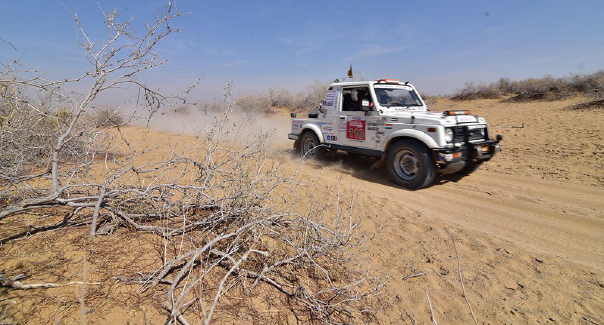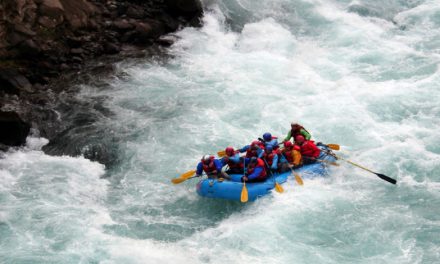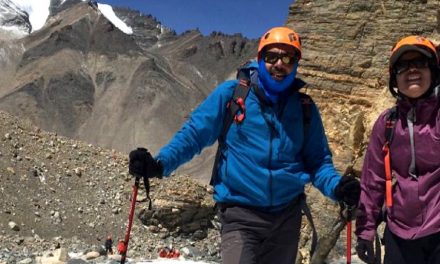
How to Prepare for a White Water Rafting Trip

How to Prepare for a White Water Rafting Trip
Rafting excursions are offered at travel destinations worldwide and can last for a few hours or an entire week. Whether riding the rapids on the Colorado River in the Grand Canyon, the Zambezi River in Zimbabwe,or floating downstream in Alaska, you can arrive prepared for the great adventure with a proper pre-raft workout plan, attire, and raft-and-paddle know-how.
Building a Pre-RaftWorkout
1) Warm up by stretching.Shoulder strain is a common white-water rafting injury and proper stretching will keep you flexible& agile. Spend five minutes before every pre-rafting workout stretchingyour muscles. To keep your shoulders loose, stretch your arms up and then across your body, holding each stretch for 60 seconds.
2) Build upper body muscles with push ups, pull ups, and chest presses. You will need a lot of upper body strength to navigate your way through Class 3 to 4 rapids. With push ups, yourform is crucial. When down on the ground, set your hands at a distance slightly wider than shoulder-width apart and imagine your body as a straight line.
If push-ups are too difficult, do four sets of wall push ups with two-minute rests between sets.Keep this up every other day, with the same form. Once you can do 4 sets of 20repetitions of wall push ups, you can progress to the inclined floor position.
3) Strengthen your core withplanks. Planks and side planks are common core exercises that develop muscles that stabilize your body when leaning into your paddle. Plant yourhands directly under your shoulders like you’re about to do a push-up. Alternatively, place your weight on your elbows and forearms. Ground the toesinto the floor and hold
for 20 seconds.
• As an additional corestrengthening exercise, lay on your back and touch each elbow with the o
pposite knee then straighten each leg.
4) Build leg muscles withlunges and squats. These exercises will strengthen your most powerful p
addling base-your legs. When lunging, keep your upper body straight, yourshoulders back and rel
axed, and your chin up. Step forward with one leg, bringing your hips towardthe ground until both knees bend at a 90 degree angle. Hold dumbbells whiledoing lunges for maximum resistance.
• For squats, stand withyour head facing forward and your feet shoulder-width apart. Sit back and godown like you’re sitting into an imaginary chair, with your thighs parallel tothe floor. Hold for 15 seconds and repeat, doing three sets of ten.
5) Build your endurance bybiking, running, or swimming. You will not be huffing and puffing in the middleof your river trip if you have several weeks of cardio training under yourbelt. Bike, run or swim to build your cardiovascular health. Include sprints,hills, and obstacles.
• Break it up with somehigh intensity interval training. Do intense work with intermittent rests using either jump rope,burpees, stationary cycle, elliptical machine, or even boxing to build up yourcardiovascular health.
6) Stretch five more minutesat the end of your workout. This will help you cool down and stay limber. Be sure to stretch your back, arms, hamstrings, and glutes. Make sure to hold each stretch 30 seconds, and breathedeeply.
7) Eat a post-workout snack.Consuming protein and carbs within 45 min after your workout will help rebuildyour body. Choose a ratio of 3 carbs to 1 protein. A protein shake with banana,hummus and pita, or tuna on whole wheat are good examples.
Packing for Your Trip
1) Bring a swimsuit. It isrecommended that women wear one-piece swimsuits and men wear swim trunks. In addition to gettingwet during the raft excursion, many white water rafting trips include an opportunity to take a dip at some point during the trip. Wet suitsare also often available to rent at the outfitter’s, in cooler climates.
2) Pack waterproof layers.Over your swimsuit,wear a lightweight shirt with an Ultraviolet Pr
otection Factor (UPF) rating of 30 or higher. When packing, choose loose, woven materials such aswool, poly-pro, fleece, micro fleece, polyester or any other outdoor materialthat dries quickly.
• Avoid any cottonclothing, especially in cooler weather. It will weigh you down and increase therelease of body heat.
• Do not wear anythingwith a hood, including ponchos and rain jackets. These are unsafe on the river.
• In cooler weather, optfor a synthetic base layer, such as Capilene or Polypropylene, a middle la
yer of fleece, and an outer waterproof jacket. If the weather is very cold,add wool socks and fleece hat that can be worn under a helmet.
3) Leave jewellery,watches and accessories at home. It’s not worth the risk of losing them in thewater. Cash, wallets and phones should also be left safety back.
4) Wear sunglasses. Seasonedguides will tell you sunglasses are absolutely necessary to protect your eyesfrom the continuous glare on the water. Bring or buy a strap for yoursunglasses to keep them snugly fitted.
5) Wear old tennis shoesor close-toed heel-strap sandals. Comfortable, well-broken-in sneakers are thebest choice for your river trip. Velcro-strap sandals with a thick, rigid sole may also be worn with or without socks,however, socks are recommended as they prevent your feet from getting a sunburn. Do not pack a new pair of shoes, which will leave you soreand cause blisters. Waterpr
oof hiking boots are not recommended, since they fill with water andweigh you down. Water sho
es are often too thin and slippery.
• Avoid crocs and flipflops, which are easily lost.
• If a rafter shows upwearing only flip flops, a guide might offer to secure them with duct tape.
6) Pack dry clothes and atowel. Even if you do not swim, you will be very wet at the end of the day andwill welcome a change of clothing. Be sure to leave your dry clothes back whereyou finish.
7) Pack a wide-brimmed sunhat. For longer trips, a wide-brimmed hat is necessary to keep from g
etting a sunburn. The wider, the better. A hat with a built-in Sun ProtectionFactor (SPF) is best.
8) Buy a large waterbottle-or even two. Many rafts are equipped with d-rings to hook your water b
ottle to, so bring a carabiner for your water bottle. A carabiner will allowyou to attach the bottle to the raft so it’s secure and easily within reach.With your water bottle in view, you can better stay hydrated.
9) Bring sunscreen. Whenrafting, you will be applying 50 SPF continually-when you wake up, before you board the boat, when your raftdocks for a quick break, after rapids, and after you swim.
• Even “waterproof”sunscreen is only water resistant for 40-80 minutes. Make sure to apply a heavy layer of sunscreen tothe tops of your thighs, over your kneecaps, and to the back and front of yourneck.
Enjoying the Day
1) Choose a professionaloutfitter. To ensure your safety, go with a well-known commercialout fitter with professional guides and quality equipment. Read online reviews or call the loca
l Parks and Recreation service to ask about the reputation of the raftingcompany.
• Find out how long thecompany has been in business under the current ownership. Ask, “What kind of training do yourguides have?” and“What government entity manages the outfitter’s permit and training practices!”
2) Make reservations inadvance. Depending on the time of year you plan to hit the water, reservations may be necessary. The summer season is the busiest time of year, so you definitely want to secure your spot in advance.
• When choosing a time togo, note that late spring and early summer usually feature more aggressive rapids, while late summer tends to have tamer rapids.
3) Be friendly and open.When arriving, introduce yourself and your friends to the guide and fellowrafters and make conversation. You will be working together in the same boat for several hours and a positive attitude will helpyou row together and make new friends.
4) Wear your personalflotation device and helmet.Your life jacket is your most important piece of equipment. It should lie snugto your body – loose enough to breathe, but unable to go over your head. Helmetswill be provided above Class I & II rapids, but it is good to wear one nomatter what level you are rafting in.
5) Listen to your guide.Your guide will be alert, giving commands, watching out for upcoming ob
stacles and narrow passageways. When they tell you to row, row! Your guidehas plenty of expe
rience and is there to keep you safe.
• Sync your paddling andlisten for commands. When the waves get harder, paddling harder helps keep yousafely planted in the boat.
6) Grip the paddle “T”.Your guide will show you how to keep one hand at the base of the paddle on theshaft, and the other over the “T” grip. This prevents black eyes and knocked-out teeth. Keep your paddle in the water-unless your guide says otherwise – also provides anextra bracing point.
7) Don’t panic if you fallin the water. Your guide will call out directions and toss you a throw bag witha rope, if necessary. Hold your arms out to your sides, feet pointing downstream, knees bent and rear up, to push off rocks andprevent unwanted bruises.
A&W












